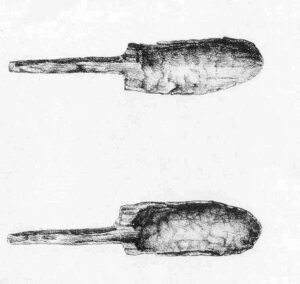Mike Haigh summarises a fascinating story of the author’s earliest experience of the past
The Alderley Edge shovel is really a dull, functional tool – but it has a remarkable story.

It begins in the early 1940s at Alderley Edge Council School in Cheshire, where local lad Alan Garner was taught the rudiments of education by a Miss Blatt, his infant teacher. While learning, the young Garner noted an old wooden shovel displayed on the wall of the classroom but thought little of it.
This Alan Garner is, of course, the same one who went on to write The Weirdstone of Brisingamen, Elidor and other children’s books of startling maturity and equally startling vision, derived from Celtic myth and imagery.
Some years later, in 1953, Garner entered Manchester Central Reference Library to annotate Weckein’s edition of Aeschylus’ Agamemnon. In spite of his good intentions, however, he soon became engrossed in Dr J D Sainter’s 1878 publication The Jottings of some Geological, Archaeological, Botanical, Ornithological and Zoological Rambles round Macclesfield.
At one point, he came across a description of a find made near his own home on Alderley Edge. The book described how a group of miners uncovered a hoard of old hammer stones near the mines. Among these was an old oak shovel, which Sainter illustrated later in the volume.
Garner recognised the object at once, but it took a few days to remember where he had seen it – on Miss Blatt’s classroom wall. When he did remember, he rushed back to his old school and asked after the old shovel. Unfortunately, the wall was bare but the caretaker thought that it might have been deposited under the school stage.
Armed with the caretaker’s torch, Alan burrowed into the gloom until he found the object of his quest. Because of his interest in the utensil, the headmistress gave it to him. He took the object straight to the Manchester Museum but was not allowed past the desk. Disappointed, Garner returned home. He was still convinced that he was in possession of an important archaeological find and resolved to do all he could to bring it to the attention of the authorities. In the meantime, he was due for conscription in the army and he was aware that his parents were apt to discard anything they didn’t understand. So the tool went into his kit bag and travelled with him throughout his army career.
Later, he took it to the British Museum, who suggested that it might be a Tudor winnowing fan. When he went to Oxford he took it to the Ashmolean. They thought that it was a Victorian toy spade, made for a child. After this, Alan stopped trying to interest archaeologists in his find and settled down to writing his remarkable books.
Throughout his writing career, Alan Garner took special care of this ancient artefact, hoping that one day he’d find a sympathetic ear. His chance came later when Manchester archaeologist John Prag made it known that he was interested in recording archaic heads. As Garner had two, he invited Prag down to view them.
During Prag’s visit, the author showed the archaeologist the shovel. Prag was sufficiently interested to have it radiocarbon dated – which placed it in the Bronze Age, c.1750 BCE and in so doing indicated that the Alderley Edge mines were amongst the oldest on this island.
In spite of this secure date there were still doubters. It seemed inconceivable to them that the shovel could survive for so long. Someone suggested that it was Victorian, but carved out of ancient bog oak.
Meanwhile, back at the mines, evidence was emerging which indicated that the mines really were ancient. Some members of the Derbyshire Caving Club found a hoard of 4th century Roman coins. The shaft was later dated to 75 CE by examining timbers found at the bottom. In 1997, the area was examined by Manchester University archaeologists who quickly established the antiquity of the workings when they found the distinctive peck marks made by stone tools. Later they found charcoal giving a radiocarbon date of around 1900 BCE, which agrees well with the date obtained for Alan Garner’s shovel.
This ancient and unprepossessing implement, which survived for millennia simply by being hidden, faced so many opportunities for disposal in the twentieth century that its survival and eventual role in uncovering obscure mining history is little short of miraculous!
[‘The Alderley Edge Shovel’, Alan Garner, John Prag & Rupert Housley. Current Archaeology 137. Feb/March 1994. Pp 172-175. ‘Legends of the Edge’, Stephanie Pain. New Scientist. Vol.171/2302. 4-8-01 pp 44-45]
Published in NE89, Spring 2002, p20-21